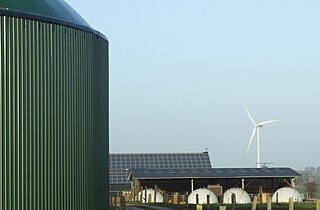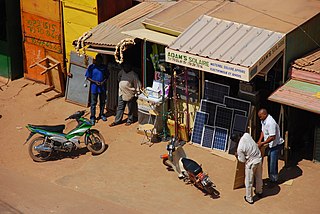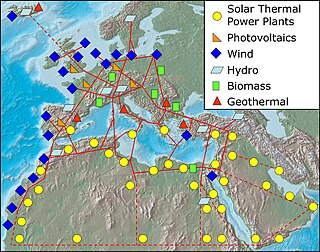Related Research Articles

Renewable energy is energy from renewable resources that are naturally replenished on a human timescale. Renewable resources include sunlight, wind, the movement of water, and geothermal heat. Although most renewable energy sources are sustainable, some are not. For example, some biomass sources are considered unsustainable at current rates of exploitation. Renewable energy is often used for electricity generation, heating and cooling. Renewable energy projects are typically large-scale, but they are also suited to rural and remote areas and developing countries, where energy is often crucial in human development.

India is the third largest producer of electricity in the world. During the fiscal year (FY) 2022–23, the total electricity generation in the country was 1,844 TWh, of which 1,618 TWh was generated by utilities.

Renewable energy plays an important and growing role in the energy system of the European Union. The Europe 2020 strategy included a target of reaching 20% of gross final energy consumption from renewable sources by 2020, and at least 32% by 2030. The EU27 reached 22.1% in 2020, up from 9.6% in 2004, but declined to 21.8% in 2021. These figures are based on energy use in all its forms across all three main sectors, the heating and cooling sector, the electricity sector, and the transport sector.

Renewable energy in Germany is mainly based on wind and biomass, plus solar and hydro. Germany had the world's largest photovoltaic installed capacity until 2014, and as of 2021 it has over 58 GW. It is also the world's third country by installed total wind power capacity, 64 GW in 2021 and second for offshore wind, with over 7 GW. Germany has been called "the world's first major renewable energy economy".

Renewable energy commercialization involves the deployment of three generations of renewable energy technologies dating back more than 100 years. First-generation technologies, which are already mature and economically competitive, include biomass, hydroelectricity, geothermal power and heat. Second-generation technologies are market-ready and are being deployed at the present time; they include solar heating, photovoltaics, wind power, solar thermal power stations, and modern forms of bioenergy. Third-generation technologies require continued R&D efforts in order to make large contributions on a global scale and include advanced biomass gasification, hot-dry-rock geothermal power, and ocean energy. In 2019, nearly 75% of new installed electricity generation capacity used renewable energy and the International Energy Agency (IEA) has predicted that by 2025, renewable capacity will meet 35% of global power generation.

A smart grid is an electrical grid which includes a variety of operation and energy measures including:

China is the world's leader in electricity production from renewable energy sources, with over triple the generation of the second-ranking country, the United States. China's renewable energy sector is growing faster than its fossil fuels and nuclear power capacity, and is expected to contribute 43 per cent of global renewable capacity growth. China's total renewable energy capacity exceeded 1,000 GW in 2021, accounting for 43.5 per cent of the country's total power generation capacity, 10.2 percentage points higher than in 2015. The country aims to have 80 per cent of its total energy mix come from non-fossil fuel sources by 2060, and achieve a combined 1,200 GW of solar and wind capacity by 2030. In 2023, it was reported that China was on track to reach 1,371 gigawatts of wind and solar by 2025, five years ahead of target due to new renewables installations breaking records.

As of 2021, German primary energy consumption amounted to 12,193 Petajoule, with more than 75% coming from fossil sources, 6.2% from nuclear energy and 16.1% from renewables. Germany is seventh in global primary energy consumption as of 2020. In 2021 Germany's electricity production reached 553.9 TWh, down from 631.4 TWh in 2013.
Brazil has the largest electricity sector in Latin America. Its capacity at the end of 2021 was 181,532 MW. The installed capacity grew from 11,000 MW in 1970 with an average yearly growth of 5.8% per year. Brazil has the largest capacity for water storage in the world, being dependent on hydroelectricity generation capacity, which meets over 60% of its electricity demand. The national grid runs at 60 Hz and is powered 83% from renewable sources. This dependence on hydropower makes Brazil vulnerable to power supply shortages in drought years, as was demonstrated by the 2001–2002 energy crisis.

Renewable energy in developing countries is an increasingly used alternative to fossil fuel energy, as these countries scale up their energy supplies and address energy poverty. Renewable energy technology was once seen as unaffordable for developing countries. However, since 2015, investment in non-hydro renewable energy has been higher in developing countries than in developed countries, and comprised 54% of global renewable energy investment in 2019. The International Energy Agency forecasts that renewable energy will provide the majority of energy supply growth through 2030 in Africa and Central and South America, and 42% of supply growth in China.

A super grid or supergrid is a wide-area transmission network, generally trans-continental or multinational, that is intended to make possible the trade of high volumes of electricity across great distances. It is sometimes also referred to as a "mega grid". Super grids typically are proposed to use high-voltage direct current (HVDC) to transmit electricity long distances. The latest generation of HVDC power lines can transmit energy with losses of only 1.6% per 1,000 km.

The Renewable Energy Sources Act or EEG is a series of German laws that originally provided a feed-in tariff (FIT) scheme to encourage the generation of renewable electricity. The EEG 2014 specified the transition to an auction system for most technologies which has been finished with the current version EEG 2017.

The United Kingdom has a National Grid that covers most of mainland Great Britain and several of the surrounding islands, as well as some connectivity to other countries. The electrical sector supplies power at 50 Hz AC, and ~240 volts is supplied to consumers. In 2020 the electricity sector's grid supply came from 55% low-carbon power, 36.1% fossil fuelled power, and 8.4% imports. Renewable power is showing strong growth, while fossil fuel generator use in general and coal use in particular is shrinking, with historically dominant coal generators now mainly being run in winter due to pollution and costs, and contributed just 1.6% of the supply in 2020.

Primary energy consumption in Spain in 2015 was mainly composed of fossil fuels. The largest sources are petroleum (42.3%), natural gas (19.8%) and coal (11.6%). The remaining 26.3% is accounted for by nuclear energy (12%) and different renewable energy sources (14.3%). Domestic production of primary energy includes nuclear (44,8%), solar, wind and geothermal (22,4%), biomass and waste (21,1%), hydropower (7,2%) and fossil (4,5%).

Ireland is a net energy importer. Ireland's import dependency decreased to 85% in 2014. The cost of all energy imports to Ireland was approximately €5.7 billion, down from €6.5 billion (revised) in 2013 due mainly to falling oil and, to a lesser extent, gas import prices. Consumption of all fuels fell in 2014 with the exception of peat, renewables and non-renewable wastes.
Latvia is a net energy importer. Primary energy use in Latvia was 49 TWh, or 22 TWh per million persons in 2009. In 2018, electricity consumption per capita was 3731 kWh.
The United Kingdom is committed to legally binding greenhouse gas emissions reduction targets of 34% by 2020 and 80% by 2050, compared to 1990 levels, as set out in the Climate Change Act 2008. Decarbonisation of electricity generation will form a major part of this reduction and is essential before other sectors of the economy can be successfully decarbonised.

China is the world's largest consumer of electricity, and its demand is expected to double by the next decade, and triple by 2035. In 2010, 70 percent of the country's electricity generation came from coal-fired power plants, but the Chinese government is investing heavily in renewable energy technologies. As of 2013, 21 percent of China's electricity generation comes from renewable sources. This represents only 9 percent of overall primary energy consumption in the country. China's latest goal is to increase renewable energy to 9.5 percent of overall primary energy use by 2015. To implement China's new clean energy capacity into the national power grid, and to improve the reliability of the country's existing infrastructure, requires significant upgrades and ultimately, a smart grid.

Renewables supply a quarter of energy in Turkey, including heat and electricity. Some houses have rooftop solar water heating, and hot water from underground warms many spas and greenhouses. In parts of the west hot rocks are shallow enough to generate electricity as well as heat. Wind turbines, also mainly near western cities and industry, generate a tenth of Turkey’s electricity. Hydropower, mostly from dams in the east, is the only modern renewable energy which is fully exploited. Hydropower averages about a fifth of the country's electricity, but much less in drought years. Apart from wind and hydro, other renewables; such as geothermal, solar and biogas; together generated almost a tenth of Turkey’s electricity in 2022. Türkiye has ranked 5th in Europe and 12th in the world in terms of installed capacity in renewable energy. The share of renewables in Türkiye’s installed power reached to 54% at the end of 2022.

Turkey uses more electricity per person than the global average, but less than the European average, with demand peaking in summer due to air conditioning. Most electricity is generated from coal, gas and hydropower, with hydroelectricity from the east transmitted to big cities in the west. Electricity prices are state-controlled, but wholesale prices are heavily influenced by the cost of imported gas.
References
- ↑ "What is the Smart Grid?". SmartGrid.gov. U.S. Department of Energy. Retrieved April 13, 2015.
- ↑ Science Applications International Corporation (October 3, 2011). "Smart Grid Around the World" (PDF). for the Energy Information Administration. Retrieved April 13, 2015.
- ↑ "South Africa Renewable Energy Auctions". IPP Renewables. South Africa Department of Energy. Archived from the original on August 9, 2013. Retrieved April 17, 2015.
- 1 2 3 4 5 "Integrated Resource Plan for Electricity 2010-2030" (PDF). South Africa Department of Energy. 2013. Retrieved April 17, 2015.
- ↑ "China: Electricity Generation by Fuel" (PDF). IEA Energy Statistics. International Energy Agency. 2014. Retrieved April 16, 2015.
- ↑ "China: Electricity and Heat for 2012". IEA Statistics. International Energy Agency. 2014. Retrieved April 17, 2015.
- 1 2 3 4 5 6 7 8 9 "China's 12th Five Year Plan". British Chamber of Commerce in China. 2011. Retrieved April 17, 2015.
- 1 2 "Grid Construction". State Grid Corporation of China. Retrieved April 17, 2015.
- ↑ Li, Jerry (2009), From Strong to Smart: the Chinese Smart Grid and its relation with the Globe, AEPN, Article No. 0018602. Available at Researchgate or the author's personal page
- ↑ International Energy Agency (July 6, 2012). "Retirement of Inefficient Plants". Energy Efficiency: Policies and Measures Databases.
- ↑ Yang, Qixun; Bi, Tianshu; Wu, Jingtao (2007). "WAMS Implementation in China and the Challenges for Bulk Power System Protection" (PDF). 2007 IEEE Power Engineering Society General Meeting. pp. 1–6. doi:10.1109/PES.2007.385835. ISBN 978-1-4244-1296-9. S2CID 10433111.
- ↑ "National Energy Efficiency Initiative - Smart Grid, Smart City - Home Page". Archived from the original on 2010-06-01. Retrieved 2010-12-02.
- ↑ "Archived copy" (PDF). Archived from the original (PDF) on 2011-03-12. Retrieved 2010-12-02.
{{cite web}}: CS1 maint: archived copy as title (link) - ↑ "Smart Grids European Technology Platform | www.smartgrids.eu". Archived from the original on 2011-10-03. Retrieved 2010-12-02.
- ↑ http://ftp.smartgrids.eu/ETPSmartGrids Archived 2017-10-15 at the Wayback Machine
- 1 2 3 4 5 6 ""The SmartGrids European Technology Platform." The SmartGrids European Technology Platform | SmartGrids, European Technology Platform, 2013, ftp.smartgrids.eu/ETPSmartGrids". Archived from the original on 2017-10-15. Retrieved 2017-10-15.
- ↑ “Smart Metering Deployment in the European Union.” Smart Metering Deployment in the European Union | JRC Smart Electricity Systems and Interoperability, Joint Research Centre, European Commission, 17 Oct. 2017, ses.jrc.ec.europa.eu/smart-metering-deployment-european-union.
- 1 2 3 4 5 “Smart Grids and Meters - Energy - European Commission.” Energy, European Commission, 4 Oct. 2017, ec.europa.eu/energy/en/topics/markets-and-consumers/smart-grids-and-meters.
- ↑ “Great Britain's Smart Grid to Revolutionise Energy Sector.” Great Britain's Smart Grid to Revolutionise Energy Sector - GOV.UK, 27 Feb. 2014, www.gov.uk/government/news/great-britains-smart-grid-to-revolutionise-energy-sector.
- ↑ http://www.techuk.org/component/techuksecurity/security/download/325?file=Introduction_to_the_UK_Smart_Grid_Sector.pdf&Itemid=181&return=aHR0cDovL3d3dy50ZWNodWsub3JnL2luc2lnaHRzL3JlcG9ydHMvaXRlbS8zMjUtb3ZlcnZpZXctb2Ytb3VyLXNtYXJ0LWVuZXJneS1wcm9ncmFtbWU=. [ dead link ]
- ↑ "About the national smart meter rollout | Smart Energy GB". www.smartenergygb.org. Retrieved 2019-09-16.
- ↑ "U.S. Energy Independence and Security Act of 2007". Archived from the original on 2016-01-15. Retrieved 2007-12-23.
- ↑ "Energy Independence and Security Act of 2007". www.govinfo.gov. Retrieved 2019-09-16.
- ↑ "EERE News: Federal Energy Regulators Propose Priorities for Smart Grid Standards". apps1.eere.energy.gov. Archived from the original on 2009-03-27.
- 1 2 "Brazil: Electricity Generation by Fuel" (PDF). IEA Energy Statistics. International Energy Agency. Retrieved April 16, 2015.
- ↑ Electric Light & Power (August 21, 2014). "Brazil Electricity Use to Increase Threefold by 2050". Newspaper. Retrieved April 16, 2015.
- ↑ Bennett, Drew. "The Smart Grid Opportunity in Brazil" (PDF). Brazil Council. U.S. Department of Commerce, International Trade Administration. Retrieved April 16, 2015.
- 1 2 Melo, E.; Neves, E.M.; Pazzini, L.H.A.; Ogawa, K. (2011). "The Design and Regulation of Brazilian Energy Markets for Alternative Sources". Presentation. Sao Paulo: Brazil Chamber of Electric Energy Commercialization.
- ↑ Green Power Conferences (June 2012). "Promising Developments around Rio +20 for Brazilian Biomass Power Generation". Newspaper. Renewable Energy World.com. Retrieved April 16, 2015.
- ↑ Trabish, Herman K. (August 29, 2011). "How Did Wind Beat the Price of Natural Gas in Brazil?". Newspaper. Retrieved April 16, 2015– via Green Tech Media.
- ↑ Meza, Edgar (July 1, 2013). "Brazil to include solar in energy auction" – via PV Magazine.
- ↑ "ANEEL Regulates Electronic Meters". ANEEL. August 8, 2012. Retrieved April 16, 2015.
- ↑ St. John, Jeff (October 11, 2012). "Brazil Smart Meter Market Drops From 60M by 2020 to 27M by 2030". Green Tech Media. Retrieved April 16, 2015.
- ↑ Nielsen, S. (March 8, 2012). "Power Theft Spurs Demands for Smart Meters at Brazilian Utilities". Newspaper. Retrieved April 16, 2015– via Bloomberg News.